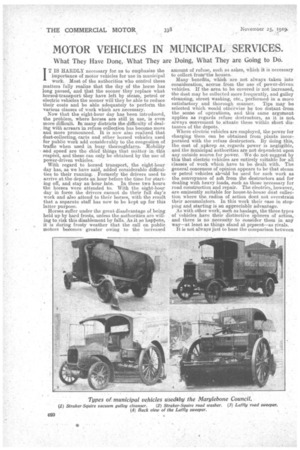MOTOR VEHICLES IN MUNICIPAL SERVICES.
Page 12

Page 13

If you've noticed an error in this article please click here to report it so we can fix it.
What They Have Done, What They are Doing, What They are Going to Do.
IT IS HARDLY necessary for, us to emphasize the importance of motor vehicles for use in municipal , work. Most of the authorities who control these matters fully realize that the day of the horse has long passed, and that the sooner they replace what horsed-transport they have left by steam, petrol. or electric vehicles the sooner will they. be able to reduce their costs and be able adequately to perforla the venous classes of work which are necessary. Now that the eight-hour day has been introduced, the prOblem, where horses are still in use, • is even more .difficult. hi many districts the difficulty of dealing with arrears in refuse collection has become more and more pronounced. It is now also realized that dust-collecting carts and other horsed vehicles used for public work add considerably to the congestion of traffic when used in busy thoroughfares. Mobility and speed are the chief things that matter, insthis respect, and these can only be 'obtained by the use of power-driven vehicles.
With regard to horsed transport, the eight-hour day has, as we have said, added considerable difficulties to their running. , Formerly the drivers used to arrive at. the depots an hour before the time for starting off, and stay an hour late. In these two hours the horses were attended to. With the eight-hour day in force the drivers cannot do their full day'swork and also attend to their horses, with the result that a separate staff has now to be kept up for this latter purpose.
Horses suffer under the great disadvantage of being held up by hard frosts, unless the authorities Fir& willing to risk this disablement by falls. As it scshaplsens, it is during frosty weather that the call on public motors becomes. greater owing to the increased
amount of refuse, such as ashes, which it is necessary to collect frorethe houses.
Many benefits, which are not always taken into consideration, accrue from the use Of power-driven vehicles: If the area to be covered is not increased, the dust may be collected -more frequently, and gulley cleansing, street washing, etc., performed in a more satisfactory and thorough manner. Tips may be selected which would otherwise be too distant from the scene of operations, and this same argutnent applies as regards refuse destructors, as it is not. always oonvenient to situate these within short dis tances of the depots. . • Where electric vehicles are employed, the power for charging them Can be obtained from plants incorporated with the refUse destructorS. By doing -this, the cost of upkeep ass regards power is negligible, and the Municipal authorities are not dependent upon ansi outside source. for poWer. We do not suggest by this that electric vehicles are entirely suitable for all lasses •of Work Which have to ha. dealt with. The general concensus of opinion appears to be that steam or petrolvehicles shsuld be used for such work as the conveyance of ash from the destructors and for dealing with heavy loads, such as those 'necessary for road construction and repair. The eleetrics,,however, are eminently suitable for house-to-house dust collection where the, radius of action doe S not overstrain their accumulators. In this work their ease in stopping and starting is an appreciable advantage. As with other work, such as haulage, the three types of vehicles have their distinctive spheres of action,. and there is no necessity to consider them in any way—at least as things stand at present—as rivals. It is not always just to base the comparison between
power-driven vehicles and horsed vehicles merely on the number of horses and tarts which the powerdriven vehicles can replace. Investigations which we• have conducted show that this may vary between two and six, according to the class of work, but, often„ advantage is taken of the higher speed of the powerdriven vehicles to increase the radius of action and
the distances between the tips or destructors and the actual place of collection. If the horsed vehicles had been called upon to undertake this extra work, the number replaced would be on an entirely different basis and still more in favour of the power-driven vehicle. No accurate comparisons of running costs can be given owing to continually changing factors.








































